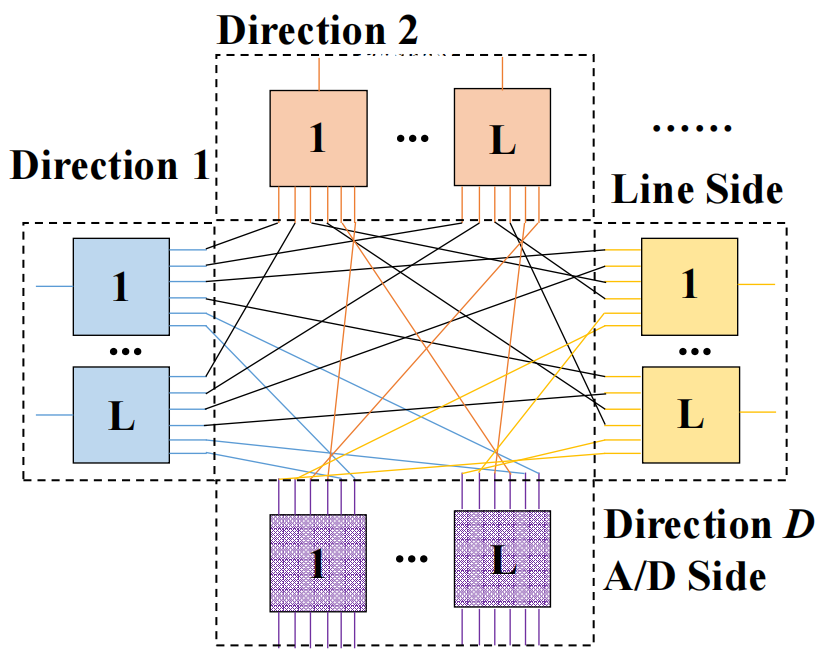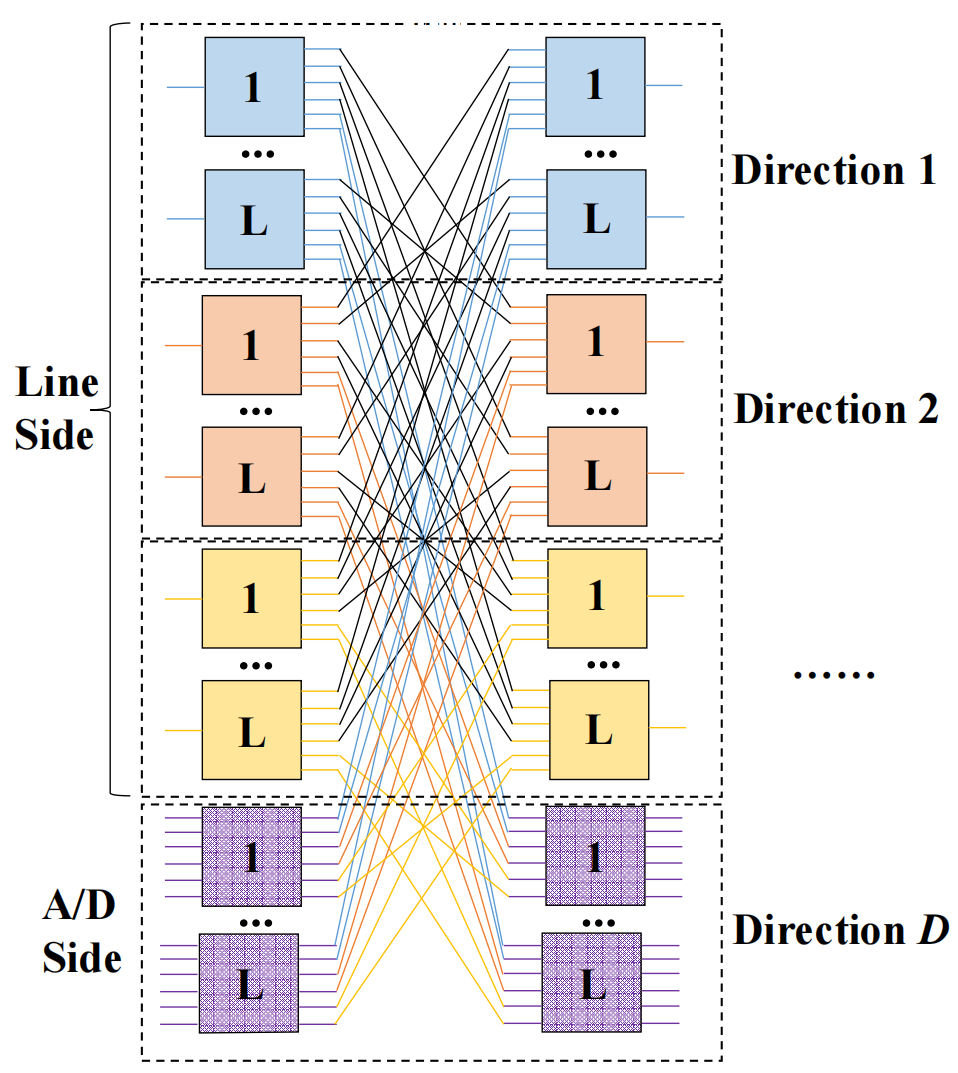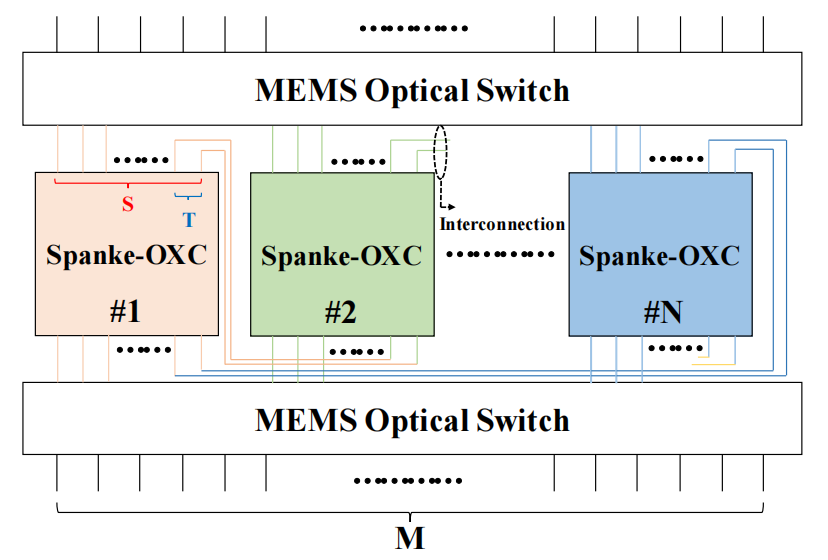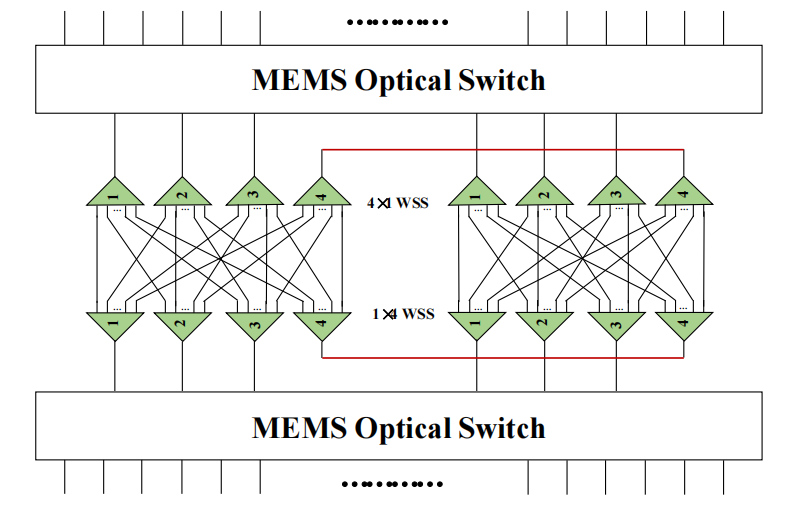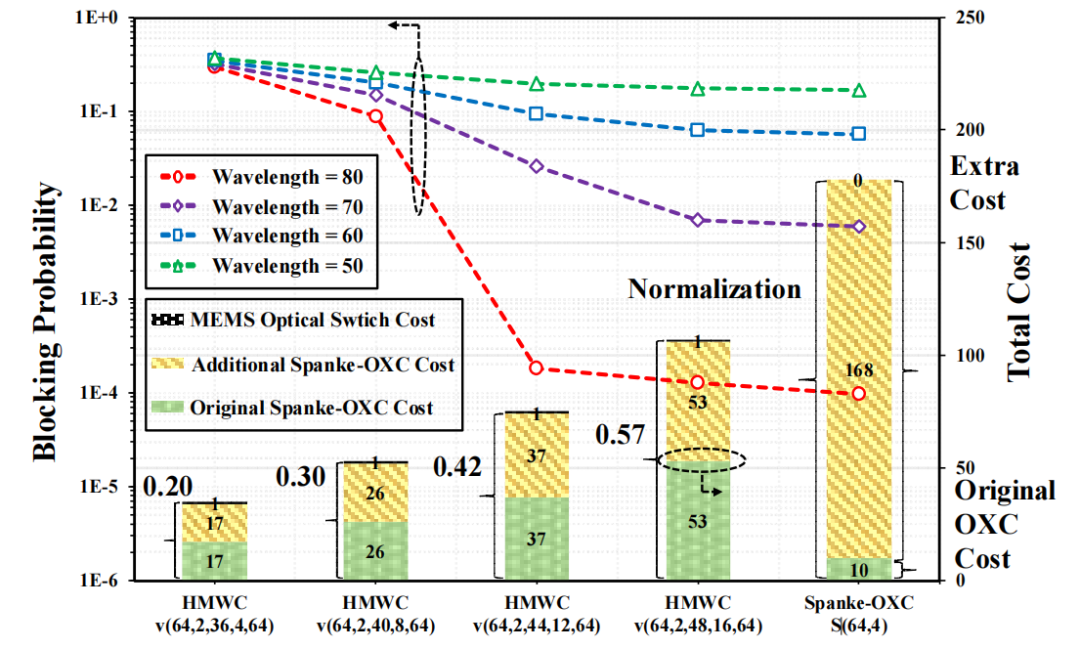OXC (optical cross-connect) is an evolved version of ROADM (Reconfigurable Optical Add-Drop Multiplexer).
As the core switching element of optical networks, the scalability and cost-effectiveness of optical cross-connects (OXCs) not only determine the flexibility of network topologies but also directly impact the construction and operation and maintenance costs of large-scale optical networks. Different types of OXCs exhibit significant differences in architectural design and functional implementation.
The figure below illustrates a traditional CDC-OXC (Colorless Directionless Contentionless Optical Cross-Connect) architecture, which utilizes wavelength selective switches (WSSs). On the line side, 1 × N and N × 1 WSSs serve as ingress/egress modules, while M × K WSSs on the add/drop side manage the addition and drop of wavelengths. These modules are interconnected via optical fibers within the OXC backplane.
Figure: Traditional CDC-OXC Architecture
This can also be achieved by converting the backplane to a Spanke network, resulting in our Spanke-OXC architecture.
Figure: Spanke-OXC Architecture
The figure above shows that on the line side, the OXC is associated with two types of ports: directional ports and fiber ports. Each directional port corresponds to the geographic direction of the OXC in the network topology, while each fiber port represents a pair of bidirectional fibers within the directional port. A directional port contains multiple bidirectional fiber pairs (i.e., multiple fiber ports).
While the Spanke-based OXC achieves strictly non-blocking switching through a fully interconnected backplane design, its limitations become increasingly significant as network traffic surges. The port count limit of commercial wavelength selective switches (WSSs) (for example, the current maximum supported is 1×48 ports, such as Finisar’s FlexGrid Twin 1×48) means that expanding the OXC dimension requires replacing all hardware, which is costly and prevents the reuse of existing equipment.
Even with a high-dimensional OXC architecture based on Clos networks, it still relies on expensive M×N WSSs, making it difficult to meet incremental upgrade requirements.
To address this challenge, researchers have proposed a novel hybrid architecture: HMWC-OXC (Hybrid MEMS and WSS Clos Network). By integrating microelectromechanical systems (MEMS) and WSS, this architecture maintains near-nonblocking performance while supporting “pay-as-you-grow” capabilities, providing a cost-effective upgrade path for optical network operators.
The core design of HMWC-OXC lies in its three-layer Clos network structure.
Figure: Spanke-OXC Architecture Based on HMWC Networks
High-dimensional MEMS optical switches are deployed at the input and output layers, such as the 512×512 scale currently supported by current technology, to form a large-capacity port pool. The middle layer consists of multiple smaller Spanke-OXC modules, interconnected via “T-ports” to alleviate internal congestion.
In the initial phase, operators can build the infrastructure based on existing Spanke-OXC (e.g., 4×4 scale), simply deploying MEMS switches (e.g., 32×32) at the input and output layers, while retaining a single Spanke-OXC module in the middle layer (in this case, the number of T-ports is zero). As network capacity requirements increase, new Spanke-OXC modules are gradually added to the middle layer, and T-ports are configured to connect the modules.
For example, when expanding the number of middle layer modules from one to two, the number of T-ports is set to one, increasing the total dimension from four to six.
Figure: HMWC-OXC Example
This process follows the parameter constraint M > N × (S − T), where:
M is the number of MEMS ports,
N is the number of intermediate layer modules,
S is the number of ports in a single Spanke-OXC, and
T is the number of interconnected ports.
By dynamically adjusting these parameters, HMWC-OXC can support gradual expansion from an initial scale to a target dimension (e.g., 64×64) without replacing all hardware resources at once.
To verify the actual performance of this architecture, the research team conducted simulation experiments based on dynamic optical path requests.
Figure: Blocking Performance of the HMWC Network
The simulation uses an Erlang traffic model, assuming service requests follow a Poisson distribution and service hold times follow a negative exponential distribution. The total traffic load is set to 3100 Erlangs. The target OXC dimension is 64×64, and the input and output layer MEMS scale is also 64×64. The middle layer Spanke-OXC module configurations include 32×32 or 48×48 specifications. The number of T-ports ranges from 0 to 16 depending on the scenario requirements.
Results show that, in the scenario with a directional dimension of D = 4, the blocking probability of HMWC-OXC is close to that of the traditional Spanke-OXC baseline (S(64,4)). For example, using the v(64,2,32,0,4) configuration, the blocking probability increases by only approximately 5% under moderate load. When the directional dimension increases to D = 8, the blocking probability increases due to the “trunk effect” and the decrease in fiber length in each direction. However, this issue can be effectively alleviated by increasing the number of T-ports (for example, the v(64,2,48,16,8) configuration).
Notably, although the addition of mid-layer modules can cause internal blocking due to T-port contention, the overall architecture can still achieve optimized performance through appropriate configuration.
A cost analysis further highlights the advantages of HMWC-OXC, as shown in the figure below.
Figure: Blocking Probability and Cost of Different OXC Architectures
In high-density scenarios with 80 wavelengths/fiber, the HMWC-OXC (v(64,2,44,12,64)) can reduce costs by 40% compared to traditional Spanke-OXC. In low-wavelength scenarios (e.g., 50 wavelengths/fiber), the cost advantage is even more significant due to the reduced number of required T-ports (e.g., v(64,2,36,4,64)).
This economic benefit stems from the combination of the high port density of MEMS switches and a modular expansion strategy, which not only avoids the expense of large-scale WSS replacement but also reduces incremental costs by reusing existing Spanke-OXC modules. Simulation results also show that by adjusting the number of mid-layer modules and the ratio of T-ports, HMWC-OXC can flexibly balance performance and cost under different wavelength capacity and direction configurations, providing operators with multi-dimensional optimization opportunities.
Future research can further explore dynamic T-port allocation algorithms to optimize internal resource utilization. Furthermore, with advances in MEMS manufacturing processes, the integration of higher-dimensional switches will further enhance the scalability of this architecture. For optical network operators, this architecture is particularly suitable for scenarios with uncertain traffic growth, providing a practical technical solution for building a resilient and scalable all-optical backbone network.
Post time: Aug-21-2025


